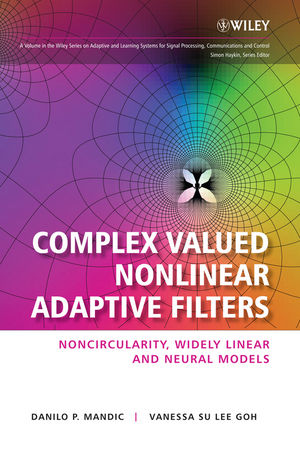Complex Valued Nonlinear Adaptive Filters: Noncircularity, Widely Linear and Neural ModelsISBN: 978-0-470-06635-5
Hardcover
344 pages
May 2009
 |
||||||
Preface xiii
Acknowledgements xvii
1 The Magic of Complex Numbers 1
1.1 History of Complex Numbers 2
1.2 History of Mathematical Notation 8
1.3 Development of Complex Valued Adaptive Signal Processing 9
2 Why Signal Processing in the Complex Domain? 13
2.1 Some Examples of Complex Valued Signal Processing 13
2.2 Modelling in C is Not Only Convenient But Also Natural 19
2.3 Why Complex Modelling of Real Valued Processes? 20
2.4 Exploiting the Phase Information 23
2.5 Other Applications of Complex Domain Processing of Real Valued Signals 26
2.6 Additional Benefits of Complex Domain Processing 29
3 Adaptive Filtering Architectures 33
3.1 Linear and Nonlinear Stochastic Models 34
3.2 Linear and Nonlinear Adaptive Filtering Architectures 35
3.3 State Space Representation and Canonical Forms 39
4 Complex Nonlinear Activation Functions 43
4.1 Properties of Complex Functions 43
4.2 Universal Function Approximation 46
4.3 Nonlinear Activation Functions for Complex Neural Networks 48
4.4 Generalised Splitting Activation Functions (GSAF) 53
4.5 Summary: Choice of the Complex Activation Function 54
5 Elements of CR Calculus 55
5.1 Continuous Complex Functions 56
5.2 The Cauchy–Riemann Equations 56
5.3 Generalised Derivatives of Functions of Complex Variable 57
5.4 CR-derivatives of Cost Functions 62
6 Complex Valued Adaptive Filters 69
6.1 Adaptive Filtering Configurations 70
6.2 The Complex Least Mean Square Algorithm 73
6.3 Nonlinear Feedforward Complex Adaptive Filters 80
6.4 Normalisation of Learning Algorithms 85
6.5 Performance of Feedforward Nonlinear Adaptive Filters 87
6.6 Summary: Choice of a Nonlinear Adaptive Filter 89
7 Adaptive Filters with Feedback 91
7.1 Training of IIR Adaptive Filters 92
7.2 Nonlinear Adaptive IIR Filters: Recurrent Perceptron 97
7.3 Training of Recurrent Neural Networks 99
7.4 Simulation Examples 102
8 Filters with an Adaptive Stepsize 107
8.1 Benveniste Type Variable Stepsize Algorithms 108
8.2 Complex Valued GNGD Algorithms 110
8.3 Simulation Examples 113
9 Filters with an Adaptive Amplitude of Nonlinearity 119
9.1 Dynamical Range Reduction 119
9.2 FIR Adaptive Filters with an Adaptive Nonlinearity 121
9.3 Recurrent Neural Networks with Trainable Amplitude of Activation Functions 122
9.4 Simulation Results 124
10 Data-reusing Algorithms for Complex Valued Adaptive Filters 129
10.1 The Data-reusing Complex Valued Least Mean Square (DRCLMS) Algorithm 129
10.2 Data-reusing Complex Nonlinear Adaptive Filters 131
10.3 Data-reusing Algorithms for Complex RNNs 134
11 Complex Mappings and M¨obius Transformations 137
11.1 Matrix Representation of a Complex Number 137
11.2 The M¨obius Transformation 140
11.3 Activation Functions and M¨obius Transformations 142
11.4 All-pass Systems as M¨obius Transformations 146
11.5 Fractional Delay Filters 147
12 Augmented Complex Statistics 151
12.1 Complex Random Variables (CRV) 152
12.2 Complex Circular Random Variables 158
12.3 Complex Signals 159
12.4 Second-order Characterisation of Complex Signals 161
13 Widely Linear Estimation and Augmented CLMS (ACLMS) 169
13.1 Minimum Mean Square Error (MMSE) Estimation in C 169
13.2 Complex White Noise 172
13.3 Autoregressive Modelling in C 173
13.4 The Augmented Complex LMS (ACLMS) Algorithm 175
13.5 Adaptive Prediction Based on ACLMS 178
14 Duality Between Complex Valued and Real Valued Filters 183
14.1 A Dual Channel Real Valued Adaptive Filter 184
14.2 Duality Between Real and Complex Valued Filters 186
14.3 Simulations 188
15 Widely Linear Filters with Feedback 191
15.1 The Widely Linear ARMA (WL-ARMA) Model 192
15.2 Widely Linear Adaptive Filters with Feedback 192
15.4 The Augmented Kalman Filter Algorithm for RNNs 198
15.5 Augmented Complex Unscented Kalman Filter (ACUKF) 200
15.6 Simulation Examples 203
16 Collaborative Adaptive Filtering 207
16.1 Parametric Signal Modality Characterisation 207
16.2 Standard Hybrid Filtering in R 209
16.3 Tracking the Linear/Nonlinear Nature of Complex Valued Signals 210
16.4 Split vs Fully Complex Signal Natures 214
16.5 Online Assessment of the Nature of Wind Signal 216
16.6 Collaborative Filters for General Complex Signals 217
17 Adaptive Filtering Based on EMD 221
17.1 The Empirical Mode Decomposition Algorithm 222
17.2 Complex Extensions of Empirical Mode Decomposition 226
17.3 Addressing the Problem of Uniqueness 230
17.4 Applications of Complex Extensions of EMD 230
18 Validation of Complex Representations – Is This Worthwhile? 233
18.1 Signal Modality Characterisation in R 234
18.2 Testing for the Validity of Complex Representation 239
18.3 Quantifying Benefits of Complex Valued Representation 243
Appendix A: Some Distinctive Properties of Calculus in C 245
Appendix B: Liouville's Theorem 251
Appendix C: Hypercomplex and Clifford Algebras 253
Appendix D: Real Valued Activation Functions 257
Appendix E: Elementary Transcendental Functions (ETF) 259
Appendix F: The O Notation and Standard Vector and Matrix Differentiation 263
Appendix G: Notions From Learning Theory 265
Appendix H: Notions from Approximation Theory 269
Appendix I: Terminology Used in the Field of Neural Networks 273
Appendix J: Complex Valued Pipelined Recurrent Neural Network (CPRNN) 275
Appendix K: Gradient Adaptive Step Size (GASS) Algorithms in R 279
Appendix L: Derivation of Partial Derivatives from Chapter 8 283
Appendix M: A Posteriori Learning 287
Appendix N: Notions from Stability Theory 291
Appendix O: Linear Relaxation 293
Appendix P: Contraction Mappings, Fixed Point Iteration and Fractals 299
References 309
Index 321



